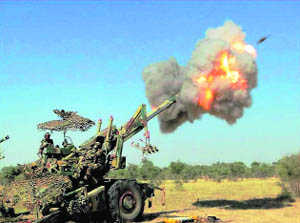In the ongoing debate on reorienting the army, the time for implementing many ideas such as downsizing and changing the defensive mindset could be premature or due to a skewed understanding of the operational environment.

It is wrong to assume the army’s offensive spirit has been eroded by the LoC fence or cessation of strillery duels. PTI
It is absolutely correct that Pakistan has achieved a fair degree of its intent through sponsoring a proxy war on our soil and India has been unable to take the response to Pakistan’s soil. Yet the Indian Army alone is not the only instrument of response. Also decisions are not taken by the Army but advice is definitely given. It is for those who receive the advice to choose the instrument of coercion. The Army is the lead agency and remains fully prepared to do what it has to, in any part of the spectrum of war.The Indian Army has been drawn into a long counter insurgency (CI) campaign in J&K through an adroit Pakistan game plan conceived 30 years ago. This happened just as the world entered into a phase which has been characterized by Hybrid War, with Conventional War taking a backseat. With nuclear parity, India conventional asymmetry with Pakistan has received a setback. Since then, India focused more on economic growth and opportunities from the prolonged restructuring of the global economy. Its emphasis on war avoidance led to a strategy (or by default) of following strategic tolerance. By contrast, Pakistan’s compulsions of attempting to maintain a bogey of deterrence and risking sponsored proxy war, has prevented it from achieving its socio-economic goals. In the long run it is still advantage India although no one can discount the attraction of Pakistan’s geostrategic location which makes it a frontline state for western support.Indian generals may not be experienced in conventional operations but not many around the world are. Anyway, experience at sub tactical level in conventional operations does not qualify for competence at operational and strategic levels. The maxim, command experience in any theatre and form is good enough for assuming higher command responsibility continues to hold good.There have been an almost obsessive chain of arguments against the LoC Fence, branding it as the chief cause of a defensive mindset. The ceasefire from 2003 actually worked to our advantage. The then army chief Gen Nirmal Vij had the clarity of thinking to begin construction well before the Pakistani ceasefire offer. The ceasefire only facilitated the construction at alignments close to the LoC. Till its completion, the ‘mathematics of terror’ was always in favor of Pakistan’s Deep State. Thousands of terrorists were killed only to see a larger number infiltrate, almost at will. The CI grid could just not handle it; high attrition was not high enough. The operationalisation of the Fence led to redeployment of resources. By 2007 there was higher attrition, the drying up of leadership and curbs on across-the-border flow of IED material, ammunition and grenades. Incidentally the last major successful IED blast took place eight years ago.The ceasefire helped in focusing on counter infiltration without any loss of aggressiveness. It is a misnomer to think that the offensive spirit is promoted by daily trans-LoC artillery duels. Removing the Fence will increase infiltration and that will require more troops. The Fence in no way curbs initiative because the Army gives it no tactical significance except for countering infiltration, a realm which, if not exploited, would amount to tactical sacrilege. It does not even metaphorically infuse a fortress mentality, let alone literal one, because enough troops are deployed ahead of it.As to the notion that the Indian Army’s 1.2 million troops are unable to deter Pakistan with half that combat power, it is never the numbers which dictate this. It is the capability and attitude of those who control the strings of decision making. Stating that 40 per cent of the army serves in CI operations in Northern Command gives credence to the Pakistani lie. If that had been so, the field to peace deployment ratio would be completely skewed; mercifully it has never come to that.The Army has competent leaders preparing for conventional war fighting. There are enough contingency plans for the Rashtriya Rifles and operationalisation of offensive options; the Army needs no advice on that. About India’s military professionals being incompetent because they donned the uniform after 1971, perhaps the opinion of some foreign institutions and armies should be taken. The Army is not in CI operations of its own volition. Get a competent replacement and it will withdraw. But, the Army’s hard won results cannot be frittered with experiments. The blood and flesh expended to regain the loss will again be that of the Army. Lt Gen DS Hooda’s decision to selectively upgrade the LoC Fence will further strengthen the CI grid and enhance the chances of zero infiltration. With no ingress from PoK and the absence of a leadership, the kinetic part of the militancy would almost be over.Principally no one can argue against the need to right size. However, collusive threats from Pakistan and China have not waned. The decision to raise two new divisions was taken after assessing and anticipating threats as also the existing voids in the order of battle. A full scale Army level war game preceded the final decision. The raising of the Mountain Strike Corps was also triggered by the prevailing environment on the Sino India front. There are still enough arguments for and against it.Lastly, the 1.7 percent allocation to the Defence budget which is slated to further reduce is a measure of the capability that we wish to develop as a nation. Given better procedures for acquisition and manufacture of select hardware within India, armed with a better equipment profile and administrated by a more competent and empathetic bureaucracy the Indian Army is quite capable of looking after both, the CI front and the conventional one without impinging on capability for either.

